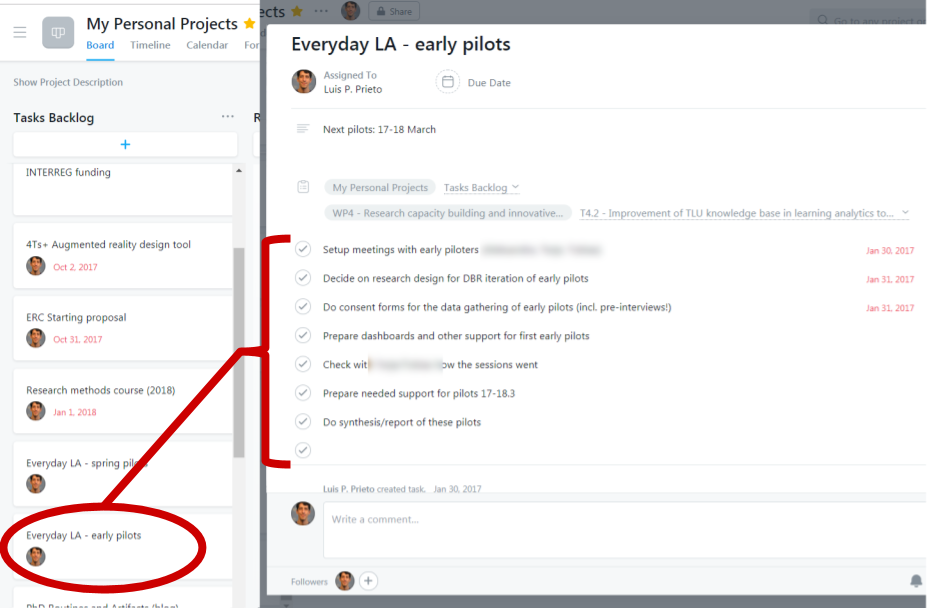POSTS
How to deal with to-do list overwhelm
by Luis P. Prieto, - 9 minutes read - 1757 wordsThe to-do list is an essential staple of an organized, reliable doctoral student (or academic). Yet, have you ever looked at your task list and felt anxious, certain that you have too much to do and too little time? In this post, I review several routines that have helped me overcome this ubiquitous feeling.
I have been working (in the industry and in academia) for about twenty years now. Yet, periodically, I look at my to-do list, or at the list of “projects I’m doing”, and I feel my heart rate rise. The grip in my stomach, the slight trembling of the hands. There is no way I’m finishing all that. Not in my whole life.
Everybody gets overwhelmed
If you ever had this feeling, it turns out you are not alone. In a recent “productivity in the Ph.D.” workshop that I facilitated, the feeling of having too many tasks was selected the most pressing problem by a majority of the twenty-something doctoral students and academics participating. This pressure on work-life balance is also mentioned in many studies about doctoral anxiety and depression.
However, the research on solutions to this problem seems rather scarce. Most of the advice on doctoral productivity notes that you should have a to-do list. And you should. A to-do list is a very powerful tool to capture tasks and deadlines, so that your head doesn’t need to remember. This works very well for many people in all walks of life. But, for many Ph.D. students, there comes a time when the captured tasks become too numerous (especially, if you use digital task management tools, which grow indefinitely). At this point, even choosing what to do next among those 147 items feels like an insurmountable task.
Part of the problem is that the to-do list has become the place where everything gets thrown: from important mandatory tasks with important consequences if not done (“do my taxes”) to wishful-thinking side projects that we are not even sure we want to do (“read more about theory X”). Self-help books and “time management gurus” give more tactical advice: remove or delegate as much of it as possible; prioritize your tasks; or align them with your top priorities. And, don’t get me wrong, that is all good advice, which I have myself followed at one time or another. By all means, read those links and do what they say. In essence, one can summarize such advice in a single idea:
Focus.
However, most of that advice is something you do once. You organize, prioritize, delegate your big to-do list… and that takes you maybe a couple of hours. There is no way you can do that very often – because you don’t have time to begin with!
Finding focus and avoiding overwhelm
Here are a few daily practices and routines that have helped me keep the to-do anxiety at bay. Some of them I skimmed from time management advice; others I took from fellow academics. I find they build on top of one another, and are increasingly difficult to pull off consistently. Thus, you could try them out one by one (e.g., adding a new one each week) rather than all at once.
- Level 0: The Daily Review. This is more of an enabler of the other routines, but it is critical. The idea is very simple: take 5-10 minutes every day to reflect on what happened today, review what you accomplished, and plan the next day. It is important to actually write (or type) things down, not just think about it. Check off the tasks you did, and write a few sentences of journaling (what interesting events happened, what was my mood, feelings, or lessons learned1). The Daily Review works best if you do it at the same time every day, maybe as a part of your daily “winding down from work” routine. For example, I do it as the start of my “go to bed” process, followed by brushing my teeth, and reading for a while. This offloads my worries and plans to a piece of paper: my brain knows that the important stuff has been taken care of. I rarely have trouble sleeping now, since I started being consistent with this routine.
- Level 1: Today’s To-do. During the Daily Review, after the short reflection on what happened today, take a look into the next day: what appointments you have in your calendar, what errands or urgent things are coming up. Visualize the “plan of attack” of how are you going to make tomorrow a great day. Then, create a separate, small to-do list with the things that you think you can do tomorrow. Just tomorrow. This list should fit into a post-it, and this is what you should keep in your pocket, in front of you at all times. The other, big to-do list, you will only look at during review time (or when adding new tasks that come up).
- Level 2: MITs. If you are like me, even the small “Today’s To-do” list is still an over-optimistic chimera, a fantastic expectation I usually fail to fulfill. In my daily reviews, I saw repeatedly 30-60% of the tasks for the day go unfinished. And the harder, long-term important tasks were often the ones left behind. Crucial projects got stuck in my task queue for weeks. Can you smell the aroma of procrastination? Enter the Most Important Tasks (or MITs) of the day2. Ask yourself: among the list of today’s tasks, is there 1-3 of them that are vastly more important than the others? something that advances your long-term priorities, even if it is not urgent today? or something that really needs to get done tomorrow, that no one else can do? Then, transform you plain to-do for the day to a simpler list of these 1-3 MITs. Add the appointments (“6pm - go to the doctor”). The rest, you can put somewhere less visible (like the back of the post-it). Think of them as optional things that you will do once the MITs have been accomplished.
- Level 3: Ditch the to-do list. Yes, you read correctly. You just stop using a to-do list altogether. But wait, I hear you scream, how do you keep yourself organized, then?? Well, you substitute the to-do list with your calendar or diary3. When a new task comes in, you do not commit to do it unless you find an adequate free time slot for it (i.e., one long enough to do the task). Building up on Level 2 above, you would place first the important stuff (i.e., the MITs)4, the unavoidable appointments and meetings, and only then, everything else (if there is time left). Managing your tasks like this has several benefits, the main one being realism. Time (and not the number of tasks) is the real, limited, non-renewable resource that we all have. This hack puts time in the focus of attention: do I have time to do all the things that I’d like? (often the answer is no). Then, I have to accept that I will not do some of those things (at least, tomorrow – but then, on what day can I place it?). Of course, as the day goes on, your initial plans change, unexpected meetings appear, things take longer than you thought… all that is normal. Just modify your calendar accordingly, and if you have to move less important tasks to another day, do it. Doing this consistently will make your productivity, triggers and temptations visible, and will act as a vaccine against our personal planning fallacies. You will become a better planner. And the Daily Review is a great time to reflect and do this kind of learning.
Simple advice, difficult to follow
Reading this post, you would probably think that I have all this to-do list stuff figured out, right?
Nope.
I am still struggling with this myself, trying to follow my own advice. For the last months I have been at Level 2 quite consistently – and I learned that I rarely achieve more than two MITs, so I don’t even try. And I’m still in the process of making Level 3 work with my own daily routines (see the photos below). I still keep a sort-of “big to-do list” which I look at in review-time… but I try to see it rather as “things I would like to do for which I don’t have a definite time”. I know many of those I will probably never do. Eventually, this list will also go away in favor of the zen-master simplicity of Level 3.
What about you? Do you also feel this to-do list overwhelm? Have you tried any of these routines? Or do you use different tricks? In both cases, do let me know in the comments below!
-
Especially, you can reflect whether you were able to do all the things that you set out to do (see the other to-do-related routines). Do you always underestimate the time tasks will take (I still do)? What derailed your plans? What were the main distractions and triggers? Can those be avoided? By writing down these things, you learn about how you plan, what makes you productive or unproductive. You will progressively become better at planning and executing what you want to accomplish. ↩︎
-
I first came in contact with this idea of MITs in Leo Babauta’s Zen to done productivity system. Tim Ferriss mentions a similar principle in his productivity advice. Both are worthy reads on their own right, if you are interested in how different people organize themselves to be productive. ↩︎
-
This hack was pointed out by Paul Rayson, in the productivity workshop I mentioned at the beginning of the post. Thanks, Paul, for the idea! ↩︎
-
Pro tip: in my experience, the tasks I do first thing in the morning have more chances to be completed. As the day goes on, the chances that something unexpected will happen (including self-distraction and procrastination) multiply. Plus, I tend to have more mental energy in the mornings. Hence, put your MITs first thing in the morning, if you can! ↩︎

Luis P. Prieto
Luis P. is a Ramón y Cajal research fellow at the University of Valladolid (Spain), investigating learning technologies, especially learning analytics. He is also an avid learner about doctoral education and supervision, and he's the main author at the A Happy PhD blog.



